Grace Robert. Advanced Blowout and Well Control
Подождите немного. Документ загружается.

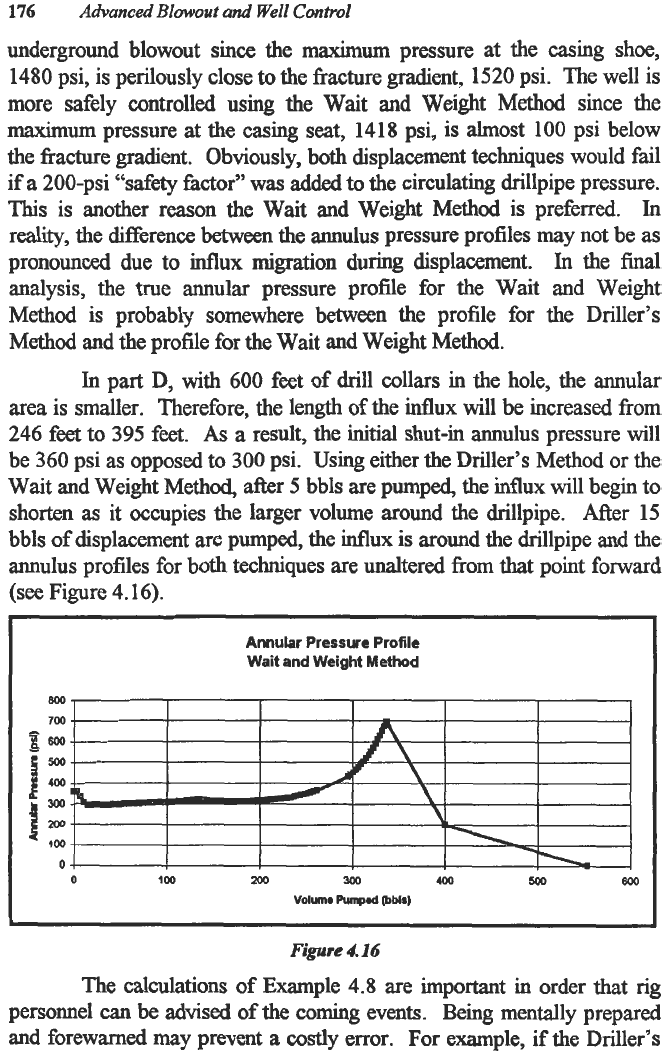
176
underground blowout since the maxifnum pressure at the casing
shoe,
1480 psi, is perilously close
to
the fracture gradtent, 1520 psi. The well is
more safely controlled using the Wait and Weight Method since the
maximum
pressure
at
the casing seat, 1418 psi, is almost 100 psi below
the fracture gradient. Obviously, both displacement techniques would fail
if a 200-psi
“safety
factor”
was
added
to
the circulating drillpipe pressure.
This
is another reason the Wait and Weight Method is preferred.
In
reality, the difference
between
the annulus pressure profiles may not be as
pronounced due to
influx migration during displacement.
In
the final
analysis, the true annular pressure profile for the Wait and Weight
Method is probably somewhere between the profile for the Driller’s
Method and the profile for the Wait and Weight Method.
In
part
D,
with
600
feet of drill collars
in
the hole, the annular
area is smaller. Therefore, the length of the influx will be increased from
246 feet to
395
feet.
As
a result, the initial shut-in annulus pressure will
be
360
psi as opposed to
300
psi.
Using
either the Driller’s Method or the
Wait and Weight Method, after
5
bbls are pumped, the influx will begin to
shorten
as
it occupies the larger volume around the drillpipe. After 15
bbls of displacement are pumped, the influx is around the drillpipe and the
annulus profiles for both techniques are unaltered from that point forward
(see
Figure 4.16).
I
Advanced
Blowout
and
Well
Control
Annular Pressure Profile
Wait and Weight Method
~~ ~
Figure
4.
I6
The calculations of Example 4.8 are important
in
order that rig
personnel
can
be advised of the coming events. Being mentally prepared
and forewarned may prevent
a
costly error. For example, if the Driller’s
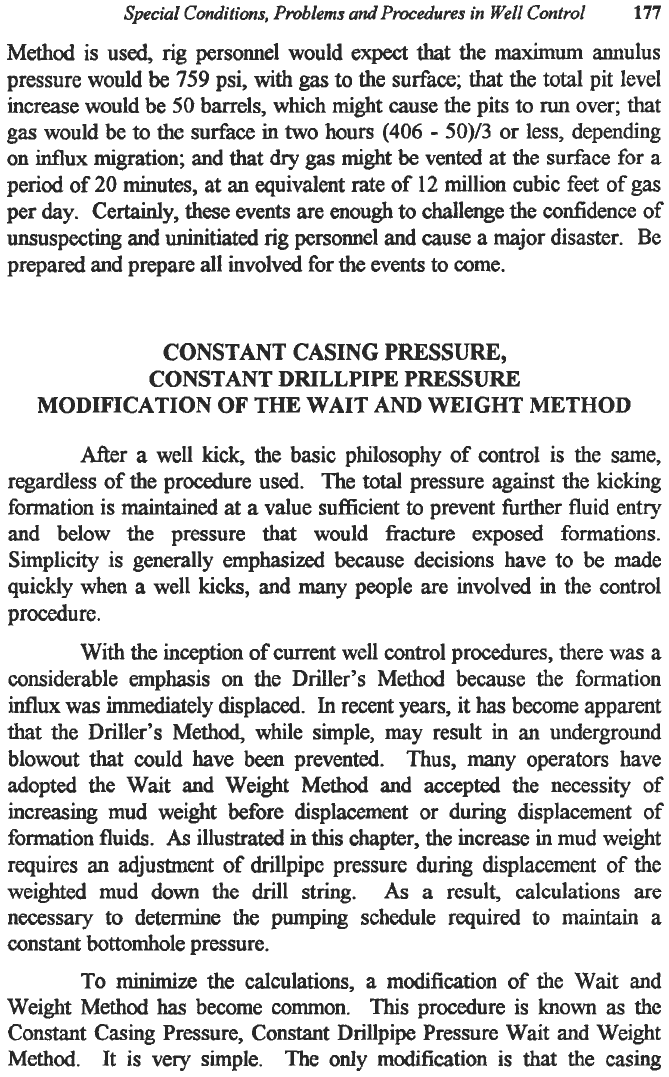
Special
Conditions,
Problems
and
Procedures
in
Well
Control
177
Method is used, rig personnel would expect that the maximum annulus
pressure would
be
759
psi,
with
gas to the surface;
that
the total pit level
increase would be
50
barrels, which might cause the pits to
run
over;
that
gas would
be
to
the surface
in
two
hours
(406
-
50)/3
or less, depending
on
influx
migration; and that
dry
gas might
be
vented at the surface for
a
period
of
20 minutes, at an equivalent rate
of
12 million cubic feet
of
gas
per day. Certainly, these events are enough to challenge the confidence
of
unsuspecting and uninitiated rig personnel and cause a major disaster. Be
prepared and prepare all involved for the events to come.
CONSTANT CASING
PRESSURE,
CONSTANT DRILLPIPE PRESSURE
MODIFICATION OF THE WAIT AND WEIGHT METHOD
After
a
well kick, the basic philosophy of control is the same,
regardless of the procedure used. The
total pressure against the kicking
formation is maintained at
a
value sufficient
to
prevent furttter fluid entry
and below the pressure that would fiacture exposed formations.
Simplicity is generally emphasized because decisions have to be made
quickly when a well kicks, and many people are involved in the control
procedure.
With the inception
of
current well control procedures, there was a
considerable emphasis on the Driller’s Method because the formation
influx was immediately displaced.
In
recent years,
it
has become apparent
that
the Driller’s Method, while simple, may result in
an
underground
blowout that could have been prevented. Thus, many operators have
adopted the Wait and Weight Method
and
accepted the necessity of
increasing mud weight before displacement or during displacement
of
formation fluids.
As
illustrated in
this
chapter, the increase in mud weight
requires
an
adjustment of drillpipe pressure during displacement of the
weighted mud
down
the drill string. As a result, calculations
are
necessary to determine the pumping schedule required to maintain a
constant bottomhole pressure.
To
minimize
the calculations, a modification of the Wait and
Weight Method
has
become common.
This
procedure
is
known
as
the
Constant Casing Pressure, Constant Drillpipe Pressure Wait and Weight
Method. It is very simple. The only modification is that the casing
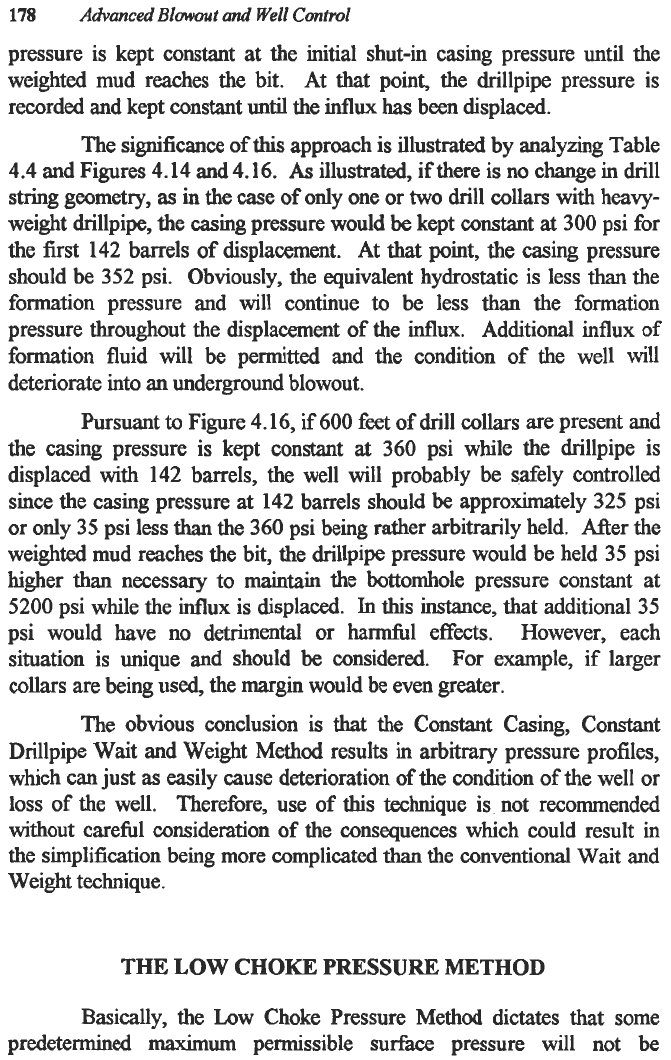
178
pressure is kept constant
at
the initial shut-in casing pressure until the
weighted mud reaches the bit. At that point, the drillpipe pressure is
recorded and kept constant until the
influx
has
been displaced.
The significance of
this
approach is illustrated by analyzing Table
4.4 and Figures 4.14 and 4.16.
As
illustrated, if there is no change in drill
string geometry,
as
in the case
of
only one or
two
drill collars with heavy-
weight drillpipe, the casing pressure would
be
kept constant
at
300 psi for
the first 142 barrels of displacement. At that point, the casing pressure
should be 352 psi. Obviously, the equivalent hydrostatic is less
than
the
formation pressure and will continue
to
be less than the formation
pressure throughout the displacement
of
the influx. Additional influx of
formation fluid will be permitted and the condition of the well will
deteriorate into an underground blowout.
Pursuant
to
Figure 4.16, if 600 feet of drill collars are present and
the casing pressure is kept constant at 360 psi while the drillpipe
is
displaced with 142 barrels, the well will probably be safely controlled
since the casing pressure at 142 barrels should
be
approximately 325 psi
or only 35 psi less
than
the 360 psi being rather arbitrarily held. After the
weighted mud reaches the bit, the drillpipe pressure would be held 35 psi
higher than necessary to maintain the bottomhole pressure constant at
5200 psi while the influx is displaced.
In
this
instance, that additional
35
psi would have no detrimental or hadl effects. However, each
situation is unique and should
be
considered. For example, if larger
collars are being used, the margin would be even greater.
The obvious conclusion is
that
the Constant Casing, Constant
Drillpipe Wait and Weight
Method
results in arbitrary pressure profiles,
which can just
as
easily cause deterioration of the condition of the well or
loss of the well. Therefore, use of
this
technique is not recommended
without careful consideration of the consequences which could result in
the simplification being more complicated
than
the conventional Wait and
Weight technique.
Advanced
Blmt
and
Well Control
THE
LOW
CHOKE
PRESSURE
METHOD
Basically, the Low Choke Pressure
Method
dictates
that
some
predetermined
maximum
permissible surfixe pressure will not be
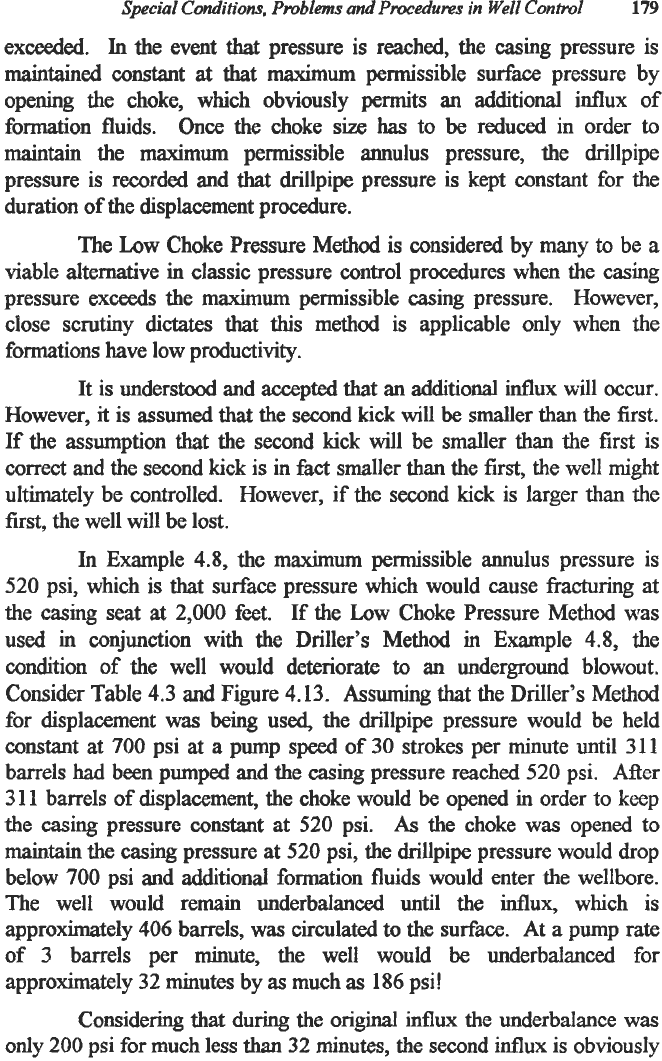
Special
Conditions,
Problems
and
Pmceduures
in
Well
Control
179
exceeded.
In
the event that pressure is reached, the casing pressure is
maintained constant at
that
maximum
permissible surface pressure by
opening the choke, which obviously
permits
an additional influx of
formation fluids.
Once the choke
size
has
to
be
reduced in order
to
maintain the maximum permissible annulus pressure, the drillpipe
pressure is recorded and that drillpipe pressure is kept constant for the
duration of the displacement procedure.
The Low Choke Pressure Method is considered by many
to be
a
viable alternative
in
classic pressure control procedures when the casing
pressure exceeds the
maximum
permissible casing pressure. However,
close scrutiny dictates that
this
method is applicable only when the
formations have low productivity.
It
is understood and accepted that an additional influx will occur.
However, it is assumed
that
the second kick will be smaller than the first.
If the assumption
that
the second kick will be smaller than the first is
correct and the second kick is in fact smaller
than
the first, the well might
ultimately be controlled. However, if the second kick is larger than the
first, the well will be lost.
In Example
4.8,
the maximum permissible annulus pressure is
520
psi, which
is
that surface pressure which would cause fracturing at
the casing seat
at
2,000
feet. If the Low Choke Pressure Method was
used
in
conjunction with the Driller’s Method
in
Example
4.8,
the
condition of the well would deteriorate
to
an underground blowout.
Consider Table
4.3
and Figure
4.13.
Assuming that the Driller’s Method
for displacement
was
being used, the drillpipe pressure would be held
constant at
700
psi at a pump
speed
of
30
strokes per minute until
3
11
barrels
had
been pumped and the casing pressure reached
520
psi. Aftcr
3
11
barrels of displacement, the choke would be opened
in
order to keep
the casing pressure constant at
520
psi.
As
the choke was opened to
maintain the casing pressure at
520
psi, the drillpipe pressure would drop
below
700
psi and additional formation fluids would enter the wellbore.
The well would remain underbalanced until the influx, which is
approximately
406
barrels, was circulated
to
the surface.
At
a
pump rate
of
3
barrels per minute, the well would
be
underbalanced for
approximately
32
minutes by
as
much
as
186 psi!
Considering that during the original influx the underbalance was
only
200
psi for much less
than
32
minutes, the second
influx
is obviously
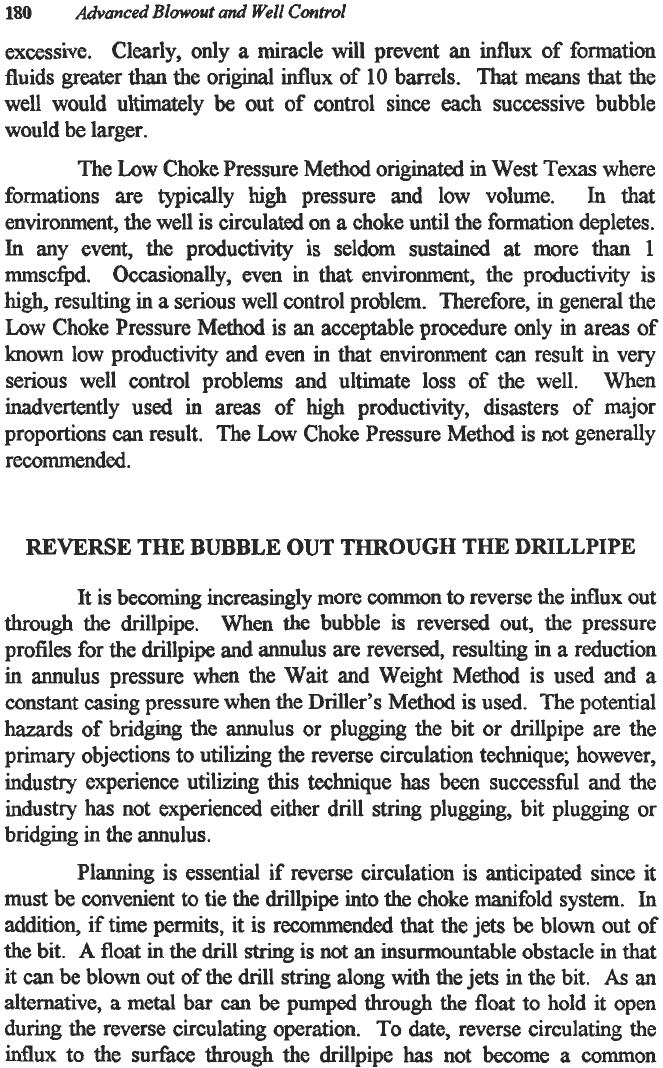
180
Advanced
Blowout
and
Well
Control
excessive. Clearly, only
a
miracle will prevent
an
influx of formation
fluids greater
than
the
ori@
influx
of
10
barrels.
That
means
that
the
well would ultimately
be
out of control since each successive bubble
would be larger.
The Low Choke Pressure
Method
originated in West Texas where
formations are typically
high
pressure and low volume. In that
environment, the well is circulated on
a
choke until the formation depletes.
In
any event, the productivity is seldom sustained at more than
1
mmscfpd. Occasionally, even in
that
environment, the productivity is
high,
resulting in
a
serious well control problem. Therefore, in general the
Low
Choke Pressure
Method
is an acceptable procedure only in areas
of
known
low productivity and even
in
that environment can result
in
very
serious well control problems and ultimate
loss of
the well. When
inadvertently used in areas
of
high productivity, disasters of major
proportions
can
result. The Low Choke Pressure
Method
is not generally
recommended.
REVERSE THE
BUBBLE
OUT THROUGH THE
DRILLPIPE
It
is becoming increasingly more common
to
reverse the influx out
through the drillpipe.
When
the bubble is reversed out, the pressure
profiles for the drillpipe and annulus are reversed, resulting
in
a
reduction
in
annulus pressure when the Wait and Weight
Method
is used and
a
constant
casing
pressure when the Driller’s Method is used. The potential
hazards
of
bridging the annulus or plugging the bit or drillpipe are the
primary objections to utilizing
the
reverse circulation technique; however,
industry experience utilizing
this
technique
has
been successful and the
industry
has
not experienced either drill
string
plugging, bit plugging
or
bridging
in
the annulus.
Planning is essential
if
reverse circulation is anticipated since
it
must be convenient
to
tie the drillpipe into
the
choke manifold system.
In
addition, if time permits, it is recommended
that
the
jets
be
blown out
of
the bit.
A
float
in
the drill
string
is not
an
insurmountable obstacle in
that
it
can
be blown out of the
drill
string along with the jets in the bit.
As
an
alternative,
a
metal bar
can
be pumped through the
float
to hold it open
during the reverse circulating operation.
To
date, reverse circulating the
influx to the surface through
the
drillpipe
has
not become a common
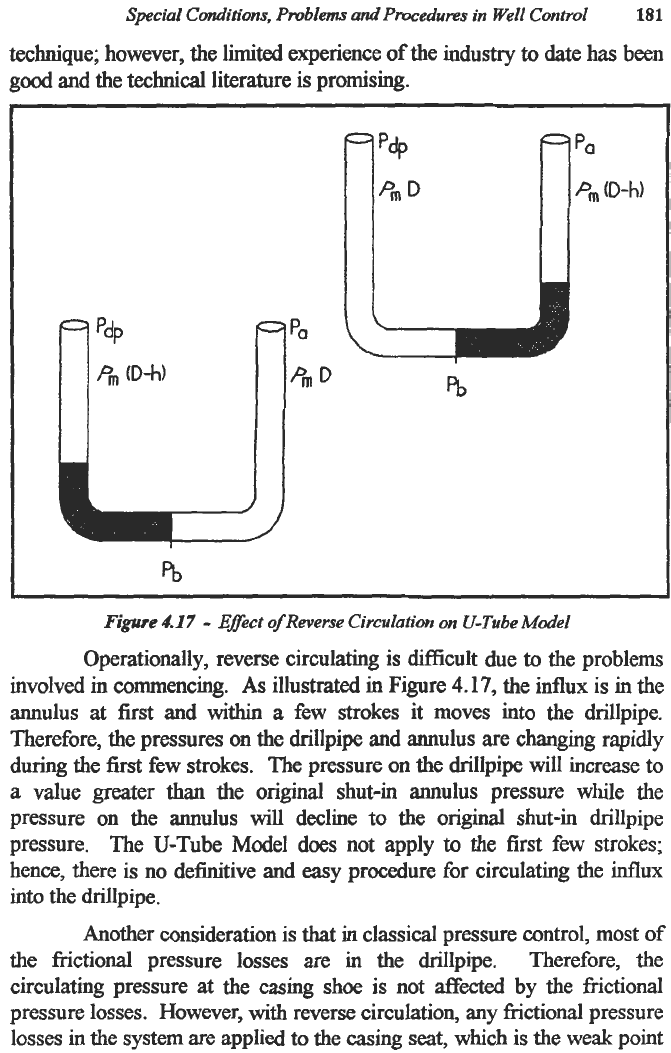
Special Conditions,
Problems
and
PmeduEs
in
Well
Control
181
technique; however, the
limited
experience of the industry
to
date has been
good and the
technical
literature is promising.
Figure
XI
7
-
Effect
of
Reverse
Circulation
on
U-Tube
Model
Operationally, reverse circulating is difficult due
to
the problems
involved in commencing.
As
illustrated in Figure
4.17,
the influx is in the
annulus at first and
within
a
few strokes it moves into the drillpipe.
Therefore, the pressures on the drillpipe and annulus
are
changing rapidly
during the
first
few strokes. The pressure
on
the drillpipe will increase to
a
value greater
than
the original shut-in annulus pressure while the
pressure on the annulus
will
decline
to
the original shut-in drillpipe
pressure. The U-Tube Model does not apply
to
the first few strokes;
hence, there is no definitive and easy procedure for circulating the influx
into the drillpipe.
Another consideration is that in classical pressure control, most
of
the frictional pressure losses are in the drillpipe. Therefore, the
circulating pressure
at
the casing shoe is not
affected
by the frictional
pressure losses. However,
with
reverse circulation,
any
frictional pressure
losses in the system are applied to the casing
seat,
which
is
the weak point
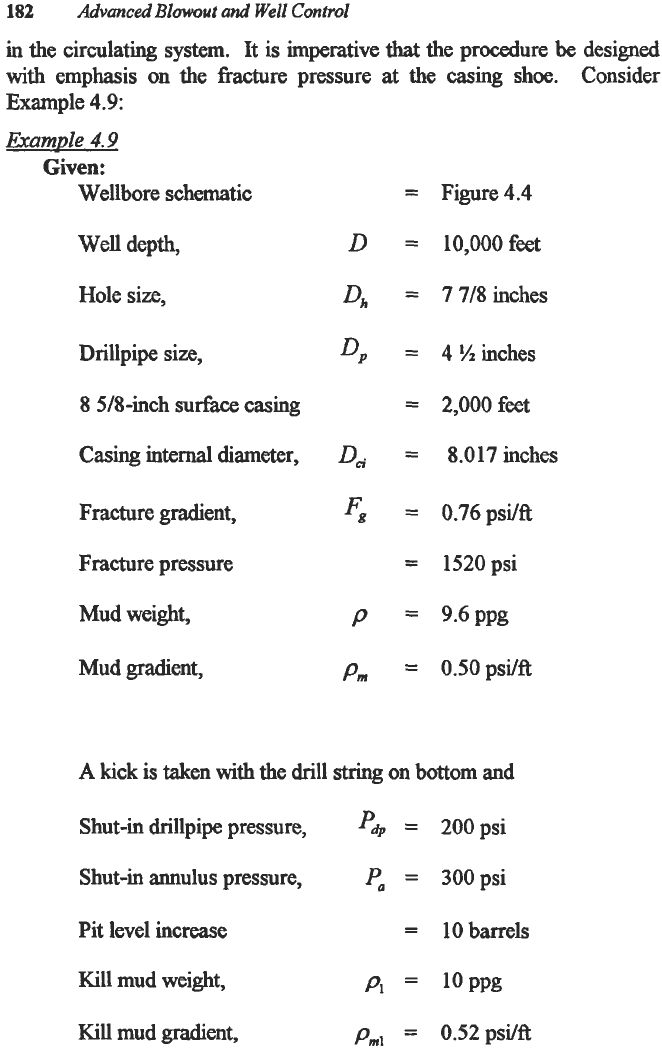
182
in the circulating
system.
It
is imperative
that
the procedure
be
designed
with emphasis on the fracture pressure
at
the casing shoe. Consider
Example 4.9:
Example
4.9
Advanced
Blowout
and
Well
Control
Given:
Wellbore schematic
=
Figure4.4
Well depth,
Hole size,
D
=
10,OOOfeet
D,,
=
7 718 inches
Drillpipe size,
Dp
=
4 %inches
8 518-inch
~~rEace
casing
=
2,OOOfeet
Casing
internal
diameter,
0,.
=
8.017 inches
Fracture gradient,
Fg
=
0.76psi/ft
Fracture pressure
=
152Opsi
Mud weight,
P
=
9.6PPi3
Mud
went,
p,,,
=
0.50psi/ft
A
kick
is
taken
with the
drill
string
on
bottom
and
Shut-in drillpipe pressure,
f&
=
200
psi
Shut-in annulus pressure,
Pa
=
300psi
Pit level increase
=
lobarrels
Kill mud weight,
h
=
1oPPg
Kill
mud
sent,
p,,,,
=
0.52
psi/ft
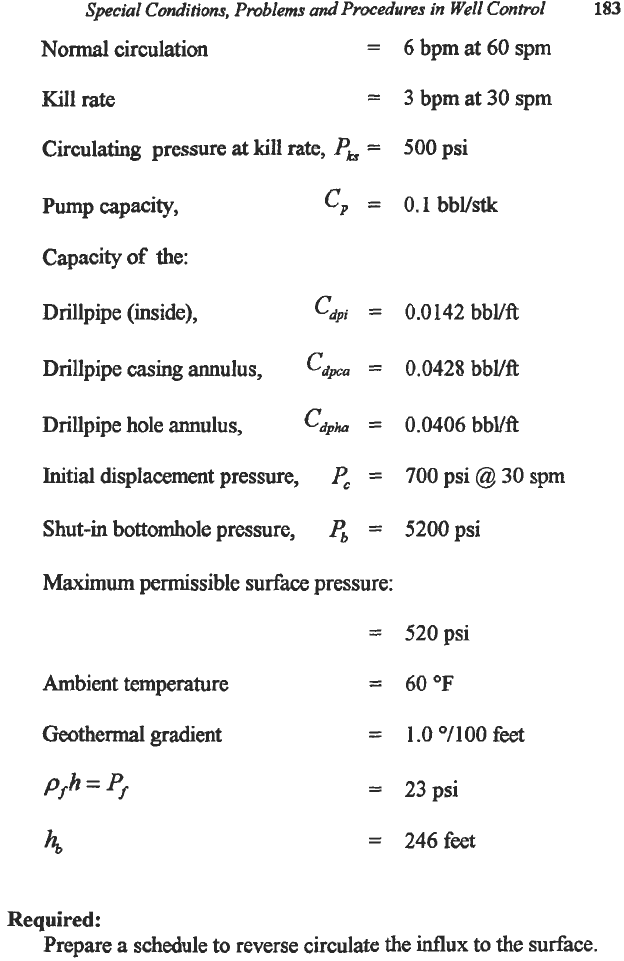
Special Conditions, Problems
and
Procedures in Well Control
183
Nod
circulation
=
6 bpm at 60 spm
Kill
rate
=
3
bpm at
30
spm
Circulating pressure
at
kill
rate,
Pks
=
500
psi
Pump capacity,
cp
=
0.1 bbVstk
Capacity
of
the:
Drillpipe (inside),
'dpi
=
0.0142 bbVft
Drillpipe
casing
annulus,
cdpca
=
0.0428bbVft
Drillpipe hole annulus,
cdph
=
0.0406bbVfi
Initial displacement pressure,
e
=
700
psi
@
30
spm
Shut-in bottomhole pressure,
pb
=
5200 psi
Maximum permissible surface pressure:
=
520psi
Ambient temperature
=
60OF
Geothed gradient
=
1.O0/10Ofeet
Pfh
=
Pf
=
23psi
hb
=
246feet
Required:
Prepare a schedule to reverse circulate the influx
to
the
surface.
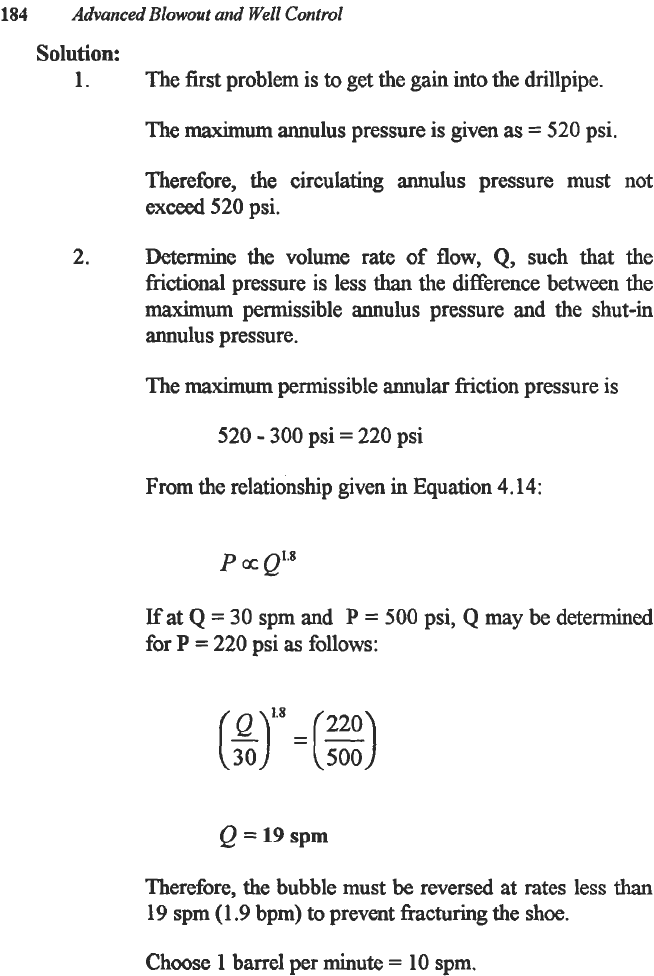
184
Advanced Blowout and Well Control
Solution:
1.
The first problem is
to
get the gain
into
the drillpipe.
The maximum annulus pressure is given
as
=
520
psi.
Therefore, the circulating annulus pressure must not
exceed
520
psi.
2.
Determine the volume rate of
flow,
Q,
such that the
frictional
pressure is less
than
the difference between the
maximum permissible annulus pressure
and
the shut-in
annulus pressure.
The maximum permissible annular friction pressure is
520
-
300
psi
=
220
psi
From the relationship given in Equation 4.14:
If
at
Q
=
30 spm
and
P
=
500
psi,
Q
may
be determined
for
P
=
220 psi
as
follows:
Q
=
19
spm
Therefore, the bubble must
be
reversed at rates less
than
19
spm
(1.9
bpm)
to
prevent fracturing the shoe.
Choose
1
barrel per minute
=
10
spm.
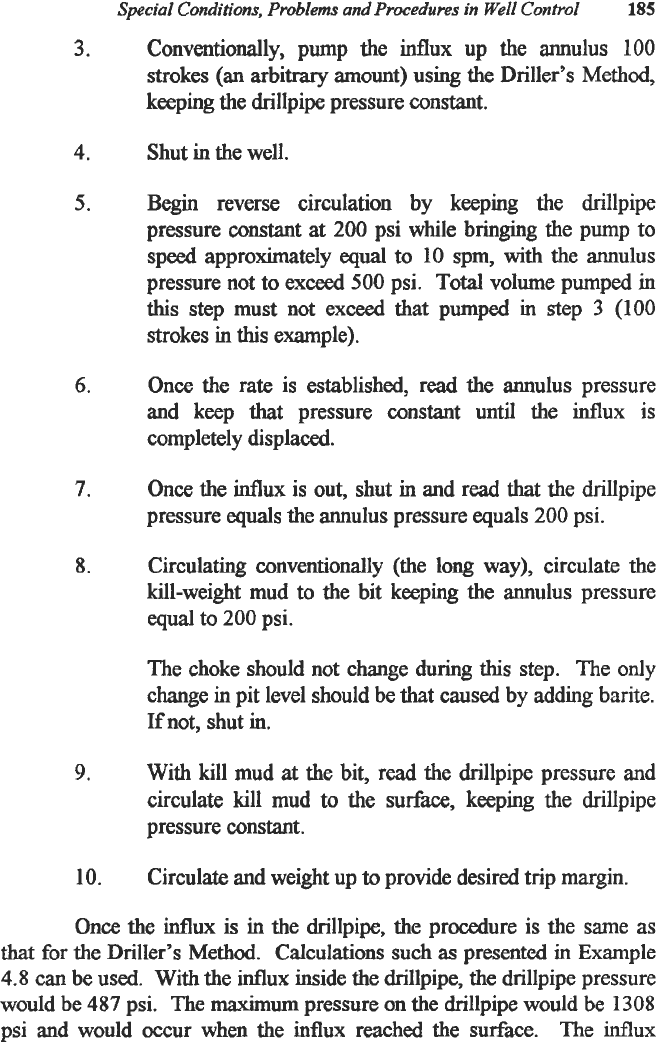
Special Conditions, Problems and Procedures in
Well
Control
185
3.
Conventionally, pump the influx up the annulus
100
strokes
(an
arbitrary amount) using the Driller’s Method,
keeping the drillpipe pressure constant.
4.
Shut in the well.
5.
Begin reverse circulation by keeping the drillpipe
pressure constant
at
200
psi while bringing the pump to
speed approximately equal to
10
spm, with the annulus
pressure not to exceed
500
psi.
Total
volume pumped
in
this
step must not exceed that pumped in step 3
(100
strokes
in
this
example).
6.
Once the rate is established, read the annulus pressure
and keep that pressure constant until the influx
is
completely displaced.
7.
Once the influx is out, shut in and read that the drillpipe
pressure equals the annulus pressure equals
200
psi.
8.
Circulating conventionally (the
long
way), circulate the
kill-weight mud
to
the bit keeping the annulus pressure
equal to
200
psi.
The choke should not change during
this
step. The only
change
in
pit level should be that caused by adding
barite.
If
not, shut
in.
9.
With
kill
mud
at
the bit, read the drillpipe pressure and
circulate kill mud to the surface, keeping the drillpipe
pressure constant.
10.
Circulate and weight up
to
provide desired trip margin.
Once the influx is
in
the drillpipe, the procedure is the same
as
that
for the Driller’s Method. Calculations such
as
presented in Example
4.8
can be used. With the influx inside the drillpipe, the drillpipe pressure
would be
487
psi.
The
maximum
pressure on the drillpipe would be
1308
psi
and
would occur when the influx reached the surface. The
influx
